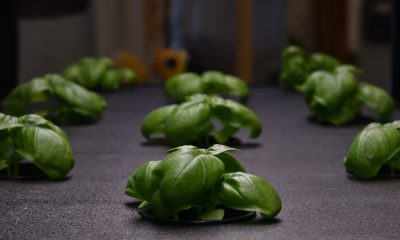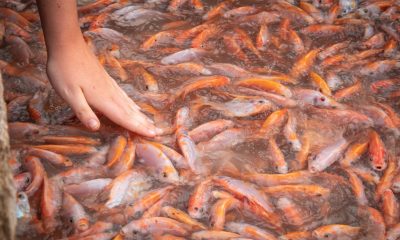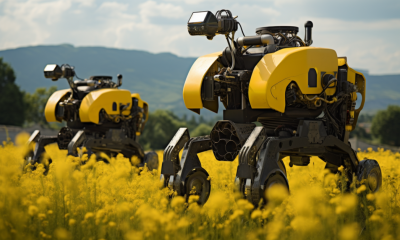Agriculture
Aeroponics – Everything You Need to Know
Securities.io is not an investment adviser, and this does not constitute investment advice, financial advice, or trading advice. Securities.io does not recommend that any security should be bought, sold, or held by you. Conduct your own due diligence and consult a financial adviser before making any investment decisions.
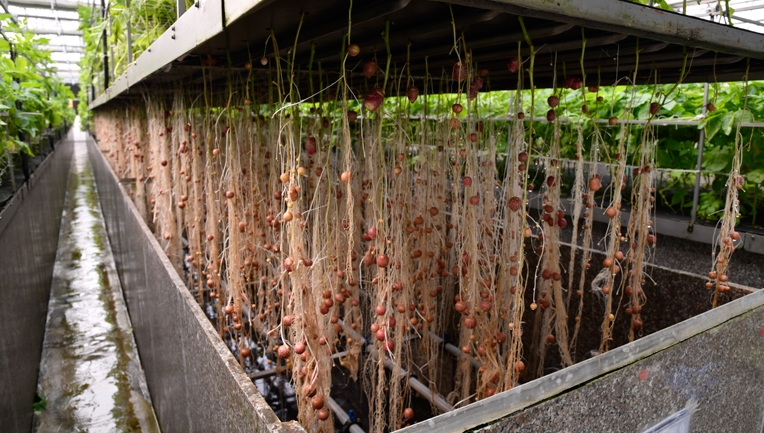
What Is Aeroponics?
Aeroponics is a cultivation method that grows plants without any soil. It is part of the broader “soil-less” cultivation methods, which also include hydroponics and aquaponics.
But contrary to these 2 other methods, it does not use any aggregate or substrate. Sometimes, the plant might be held in place with a very light substrate like coco-coir, with the root dangling support-free.
Instead, the nutrients are delivered to the plant through droplets or a sprayed mist of aerosolized water containing the dissolved nutrients.

Source: Modern Farmer
The main point of this method is to bring the most control one can get over the plant growth conditions, as well as remove most medium for diseases (soil and water).
The aeroponics market size represents $2.7B billion in 2023 and is expected to grow to $17.4B by 2033, with a 20.5% CAGR.
The Science of Aeroponics
In aeroponics, the nutrients like phosphate, potassium, and nitrogen (“NPK”) as well as micronutrients are dissolved into the water, allowing for an almost 100% efficiency in the use of fertilizers. The difference with hydroponics is that the water is not always present but is regularly sprayed on the roots.
Aeroponics can be separated into 2 different designs: low-pressure and high-pressure systems.
High-pressure systems use strong pumps and highly pressurized nozzles to throw a high-pressure mist straight at the roots. Pressure can be as high as 60-90 psi. The mist is highly oxygenated, allowing for an efficient intake of nutrients.
Low-pressure systems use a gentle mist or droplets to water the roots of the plant. In this system, the mist is a light spray of droplets, allowing for a slow and regular absorption of the nutrients. This is preferred to high pressure for sensitive plants whose roots would be damaged by high pressure, or for a low-tech approach to the method. Low pressure is sometimes called “soakaponics” as the roots are soaked with the mist instead of targeted with high pressures.
What Can Be Grown With Aeroponics?
In theory, almost every plant can be grown with aeroponics. However, cost considerations result in the crops cultivated in aeroponics being mostly the same as in hydroponics: high-value, high-quality crops with steady market demand in all seasons.
So aeroponics systems are especially adapted to grow:
- Leafy greens (salads, spinach, etc.).
- Herbs.
- Strawberries.
- Tomatoes.
- Paprika.
- Cucumber.
In addition to these hydroponics & aeroponics-friendly crops, aeroponics can grow root crops that rot when constantly immersed in water. So potatoes and carrots and other tubers can be grown as well.
Crops where the chemical composition is important and therefore require stable and predictable growth conditions, like marijuana, also benefit from aeroponics methods.
The Pros Of Aeroponics
Some of the advantages of aeroponics are similar to those of other soil-less methods, which we discussed in further detail in our articles “Hydroponics – Everything You Need to Know” and “Aquaponics – Everything You Need to Know”:
- Reduced water usage, 80-95% of conventional agriculture.
- Close to 100% usage of the fertilizers, with no pollution.
- There is no need for herbicide.
- Control over the growth conditions.
- Maximized use of space, especially if combined with vertical farming.
In addition to these, aeroponics has a few unique advantages.
Pest And Disease Control
Going soil-less obviously removes the risk of soil-born diseases. However, hydroponics are still vulnerable to water-borne diseases, as the roots are constantly dangling in the same batch of water.
By having much less water in the system, it becomes easier to monitor the water for the presence of pathogens. It also makes it easier to clean, filter, or sterilize the water if contamination is detected.
As a result, aeroponics is a farming method that requires far less use of pesticides, even less than hydroponics.
Having very clean water & no soil also makes aeroponics one of the safest cultivation methods for consumers, with little possibility of any contamination with harmful bacteria.
Quicker Growth
Thanks to the extreme level of oxygenation of the roots, the plants in aeroponics conditions can grow as fast as 2-3x quicker than in hydroponics, itself often quicker than in potted plants in greenhouses or open fields.
This can make the same cultivation surface ultra-productive for quick-to-harvest crops like leafy greens.
Root Crops
As previously mentioned, aeroponics is the only soil-less and vertical farming method compatible with cultivating root crops like potatoes, carrots, parsnips, etc.
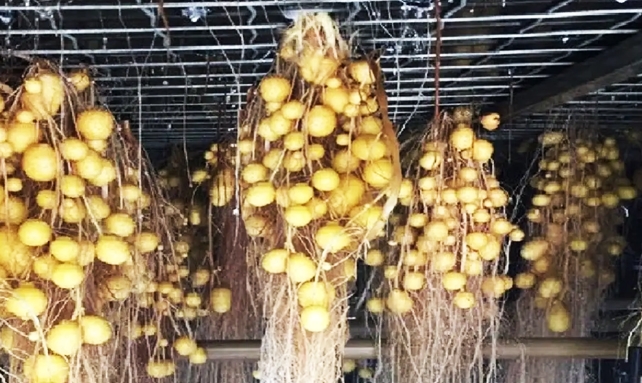
Source: Cipotato
In addition, as the roots are directly dangling to be sprayed, it is possible to access them directly. This can be a solid advantage for cultivating root crops in vertical farming by making the harvest extra practical and with no soil to clean from the harvested tubers.
The Cons Of Aeroponics
Costs
Like all soil-less cultivation methods, cost is an issue, especially start-up costs. Aeroponics requires dedicated facilities, equipment, sensors, filters, etc. In addition to hydroponic systems, it also requires nuzzles (of commercial grade for high-pressure systems) and strong pumps, as well as pressuring tanks.
pH & Nutrient Monitoring
This is not unique to aeroponics but is even more sensitive here. This is because the volume of water is severely decreased, making the nutrient concentration much higher.
This also means that the nutrients need to not be too concentrated. As there is no soil or water to provide a buffer, the quantity of nutrients delivered to the plants must be calculated precisely.
This makes it a lot more complex and knowledge-intensive than other cultivation methods, where a little overload of nutrients would be of no consequence.
So aeroponics systems are constantly treading a thin line between too high nutrient concentration (causing ionic and pH stress to the plant) and too little (causing sub-optimal growth).
Resilience
Hydroponic systems are, by nature, more artificial than crops in an open field. This means they are depending on things running smoothly:
- Supply chain in parts and components.
- Electric power supply.
- Electronic connected system for highly automated and advanced operations.
- Skilled labor able to perform efficiently the required monitoring and maintenance.
While there are ways to mitigate these risks, for example with systems redundancy or larger inventory (which adds to setup costs), or localized supply of energy through renewable power generation, aeroponics will never be as resilient as a rain-watered crop in an open field.
All of these could be said for hydroponics as well. But this is even more critical for aeroponics, with the roots needing constant mist to stay hydrated and not take damage.
So, even a few hours of outages from a faulty pump or power supply can derail an entire aeroponics harvest. For this reason, some aeroponic systems have a hydroponic backup to flood the crops in case of a temporary failure of the aeroponics. Of course, such backups only add to costs and complexity.
Complexity
And complexity is another issue of aeroponics. Not only does the system need to be monitored for diseases and nutrient balance, but it also contains many more parts than a hydroponic system. Each root is sprayed individually by one or several nozzles emitting the mist. These nozzles might become clogged or faulty. Each is supplied with its own piping system.
The more parts, the more chance for something to go wrong, making aeroponics a much more maintenance and monitoring-intensive system overall and more complex to set up initially.
Innovation In Aeroponics
LED Lighting
LED lights are a crucial technology intervention in aeroponics. These lights consume far less energy, emit less heat, and last longer than other light sources.
In addition, not all the visible light spectrum is useful for plants in photosynthesis, so dedicated LEDs without green light can further reduce the electricity consumed by artificial lightning.
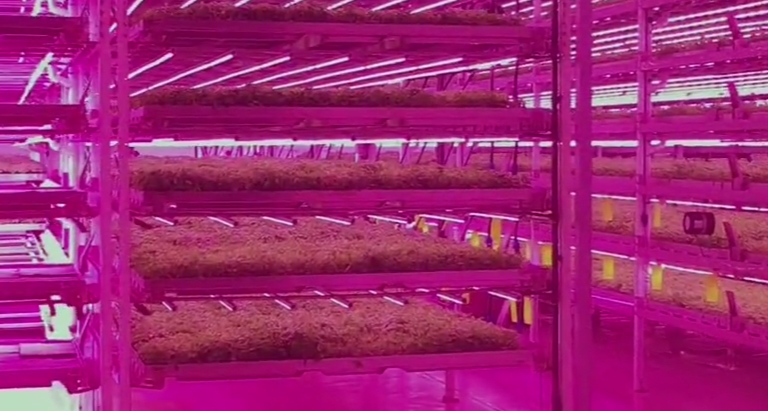
Source: Agritecture
IoT & Sensor-Based Automation
The declining costs of sensors and electronics have made continuous monitoring of temperature, humidity, light, pH levels, and nutrient volume possible.
This sensor-based farming helps to track and adjust in real-time so that the conditions stay optimal at all times. Considering the especially high level of monitoring required by aeroponics, cheap and powerful sensors are even more important for this method than for any other.
AI-Based Technologies
As mentioned, aeroponics requires intense monitoring of the water system, diseases, nutrient levels, etc.
AI can help optimize environmental conditions, including light, humidity, and nutrient levels. AI also helps optimize investment and bring down costs by creating personalized growth plans for each plant type.
It can also use machine vision or biochemical tests to warn about pathogens before a human can or find out if a plant is not getting enough or too much of some nutrients.
Lastly, with the rise of autonomous farming robots, we can envision an aeroponics system where planting, pruning, harvesting, and replacing plants can be fully automatic.
Ultra-sonic Foggers
“Traditional” aeroponics use low or high-pressure nozzles to create a mist with more or less large particles of aerosolized water.
An alternative is to use ultrasound to create ultra-small water droplets, similar to fog. The particles can be as small as 10 microns. For this reason, this is sometimes called “fogponics”.

Source: Trees.com
One type of culture that benefits from using fog is seedlings and clones, which do not really have a root system yet. With aeroponics, these plants could receive either too little and dry out or too much and clog and suffocate/rot.
Fogponic offers much lower pressure, which is ideal for fragile plants. The fog can also be spread to a much larger area, reducing the complexity and problem of having too many nozzles and replacing it with just a few foggers.
It also delivers fewer nutrients, a bonus for clonings or seedlings, but might become an issue for larger mature plants.
However, the system has some limitations:
- Heat generation: the atomizer might overheat, and it will dry the fog
- Salt accumulation: even more than with aeroponics, a deposit of salt from the nutrients can pile up and clog the atomizers and piping. Regular cleaning by brushing or dissolving the salt in vinegar/acid might be needed.

Source: Luttusgrow
Space-Based Aeroponics
With a new space race going on and plans to install permanent bases on the Moon and Mars by the USA, Russia & China, the question of how to feed dozens or even hundreds of astronauts becomes more pressing.
The more people, the less importing all the food from Earth will make sense economically. Still, these artificial habitats will be small, and every kilo/cubic meter of habitat and eventual greenhouse will cost a lot to build and be brought on site.
So producing food locally makes sense to reduce transport costs, and it will produce oxygen and recycle the air as a side bonus, but only if it's very efficient. The costs and scarcity of space and water make aeroponic systems a very good option for space-based food production, with the reduced risk of plant diseases another argument in its favor.
The possibility to grow very energy-dense root crops, like potatoes, which are also easy to eat without too complex cooking (contrary to cereals), is also favoring aeroponics over other solutions.
On top of everything, a mist of water will likely be much more practical than liquid water without gravity.
And this is not just a concept, with the prototype already tested in the ISS under the eXposed Root On-Orbit Test System (XROOTS) tech demo program.

Source: NASA
Building An Aeroponic Installation
Overall, hydroponics are simpler, cheaper to build, and easier to maintain than aeroponics.
So when planning to build an aeroponic installation, a good question to answer is why choose aeroponics over hydroponics?
Still, there are plenty of use cases where it will make sense to prefer aeroponics:
- Growing seedlings or clonings.
- Growing root crops in a vertical farming setup.
- Growing plant species that are very sensitive to water-borne diseases.
- Extreme limitations on water supply (desertic locations), focusing on using even less water than hydroponics.
- Quicker growth adds value:
- Space availability is critical, such as in urban farming and ultra-local cultivation.
- Demand fluctuates quickly or is hard to predict, so a quicker turnover allows for a quick response to growing or shrinking demand.
In most cases, commercial operations will use aeroponics, as it is more complex to set up and operate than simpler hydroponics.
Still, it is possible to use homemade smaller-scale systems, as they will very quickly provide turnover for a low volume, allowing, for example, to have a small system in a house or a flat where hydroponics’ running water and water tanks would be inconvenient.
Conclusion
Aeroponics is a powerful upgrade over hydroponics for certain conditions, delivering superior performance regarding growth speed, water usage, disease risks, and space usage.
It is, however, an even more complex, expensive, and hard-to-maintain system.
The abundance of nozzles, or the salt build-up in the case of fogponics will require constant attention to keep the system tuning optimally. And any failure will quickly result in the plant wilting and dying.
So aeroponics is likely a system either fit for a small hobby project, where space is the largest constraint and quick turnover looked after, or for a high-tech, highly experienced commercial team ready to look to optimize their indoor farming operations.
And it could be that aeroponics is the future of indoor farming, thanks to a wider crop range including root crops, lower water usage, lower losses from disease & even quicker crop turnover.
Something that might even be true when mankind expands to outer space.


